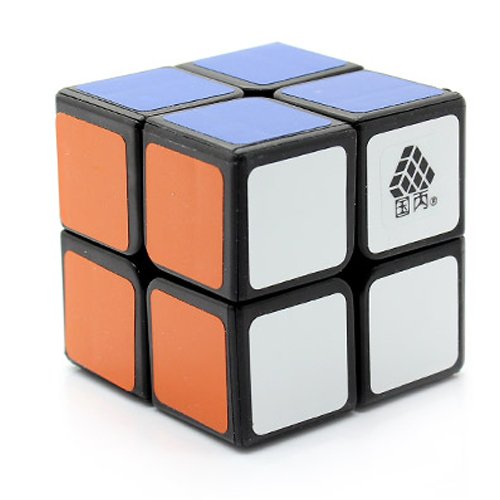
(If it has a yellow sticker, it belongs on the top and not in the middle.) Once you find an edge without a yellow sticker, rotate the top face of the cube until the outward facing sticker on that edge piece is directly over the center piece of the same color. Here are a few images of the different cases. These 4 cases are as follows: Solved, 1 big corner out of rotation, 1 small corner out of rotation, 1 big and 1 small corner out of rotation. Identify edge pieces on the top layer that do not have yellow stickers. Push your top layer back down and you will notice that your 2x2 gear cube is nearly solved. If you have an outward facing white sticker in the bottom layer, face it toward you and position the cube so that it is either in the bottom left or bottom right corner of the side facing you, and perform either the left or right trigger, respectively, to relocate it to the top face of the cube. If you have a white sticker facing the top, position the white sticker over something that is not white (because it will disrupt whatever is underneath), and, depending on if the piece is on the right or on the left, perform the following algorithm: If the matched sticker is left of center, perform the Left Trigger. If the matched sticker in the top layer is right of the center, perform the Right Trigger. Once you’ve paired them, face the color-matched stickers toward you. (Planes are an ideal place to practice cubing.) The improvements came more slowly after that, but within a fortnight I’d lowered my average solve time to a little under 60 seconds. I broke the two-minute barrier a couple days later, on a cross-country flight to Florida. Then I practiced performing them faster and more precisely.īy day three I was solving the cube in under four minutes. First I memorized a handful of algorithms (cuber lingo for defined sequences of moves known to advance a cube closer to its solved state). But I kept at it: For two weeks I spent at least 20 minutes a day scrambling my cube and solving it the way Mao had taught me. My first time solving the cube on my own took me more than 20 minutes. Ninety seconds is not fast by speedcubing standards (the world’s fastest cubers average well below 10 seconds per solve), but Mao said it would be a respectable time for a dabbler such as myself. Afterwards he told me that, with practice, I could probably get my average solve time down to under a minute and a half. Tyson Mao, a cofounder of the World Cube Association, came to WIRED’s offices and spent about an hour teaching me his go-to beginner’s method. Finally, you have to insert the last edge with a face rotated 45 degrees (just like you did to take it out).Earlier this year, while putting together a video about the world’s fastest solvers of the Rubik’s Cube, I decided to devote some time to learning to solve the classic puzzle myself. Now, put the pieces back in the cube, but this time in the correct position. Once you have taken out an edge, it’s easy to take out the rest of the pieces you need to change. Put a thumb on each edge and make pressure in opposite directions. To take out the pieces of the cube, turn 45 degrees one face (see photo). Therefore, it is advisable to solve most of the cube, so you don’t have to remove and replace so many pieces. In order to fix the cube, you need to take out the pieces that are not properly in place and put them back so that the cube is fully solved. If the piece is now put back in the cube in a different position or orientation, the cube will now be impossible to solve. Most of the times, the Rubik’s Cube becomes unsolvable because someone, intentionally or unintentionally, takes one or more pieces out of the cube. Why there are Rubik’s Cubes that can’t be solved

If you’re looking at Rubik’s Cube solutions and your case does not correspond to any of those represented, then your cube in unsolvable.


 0 kommentar(er)
0 kommentar(er)
